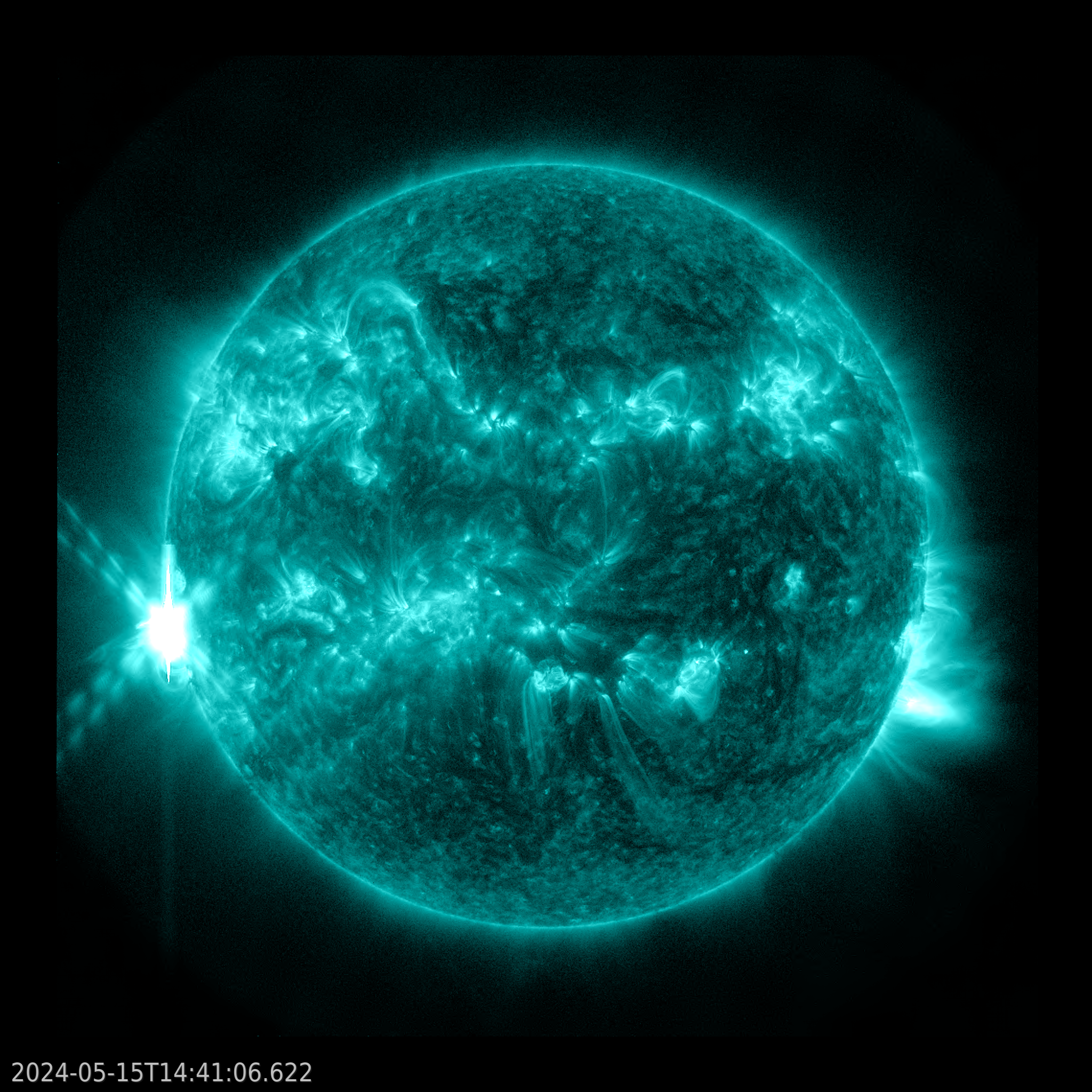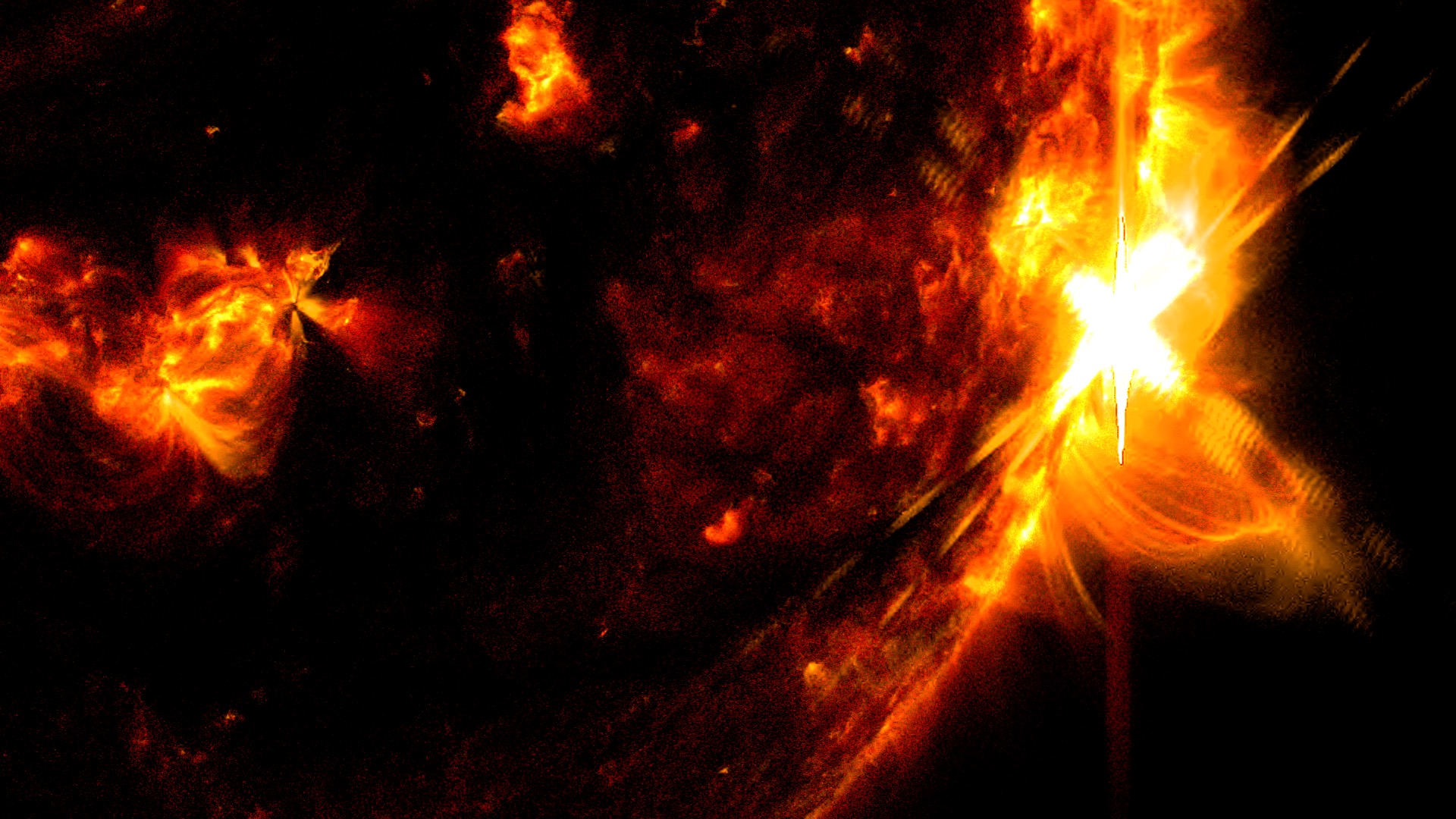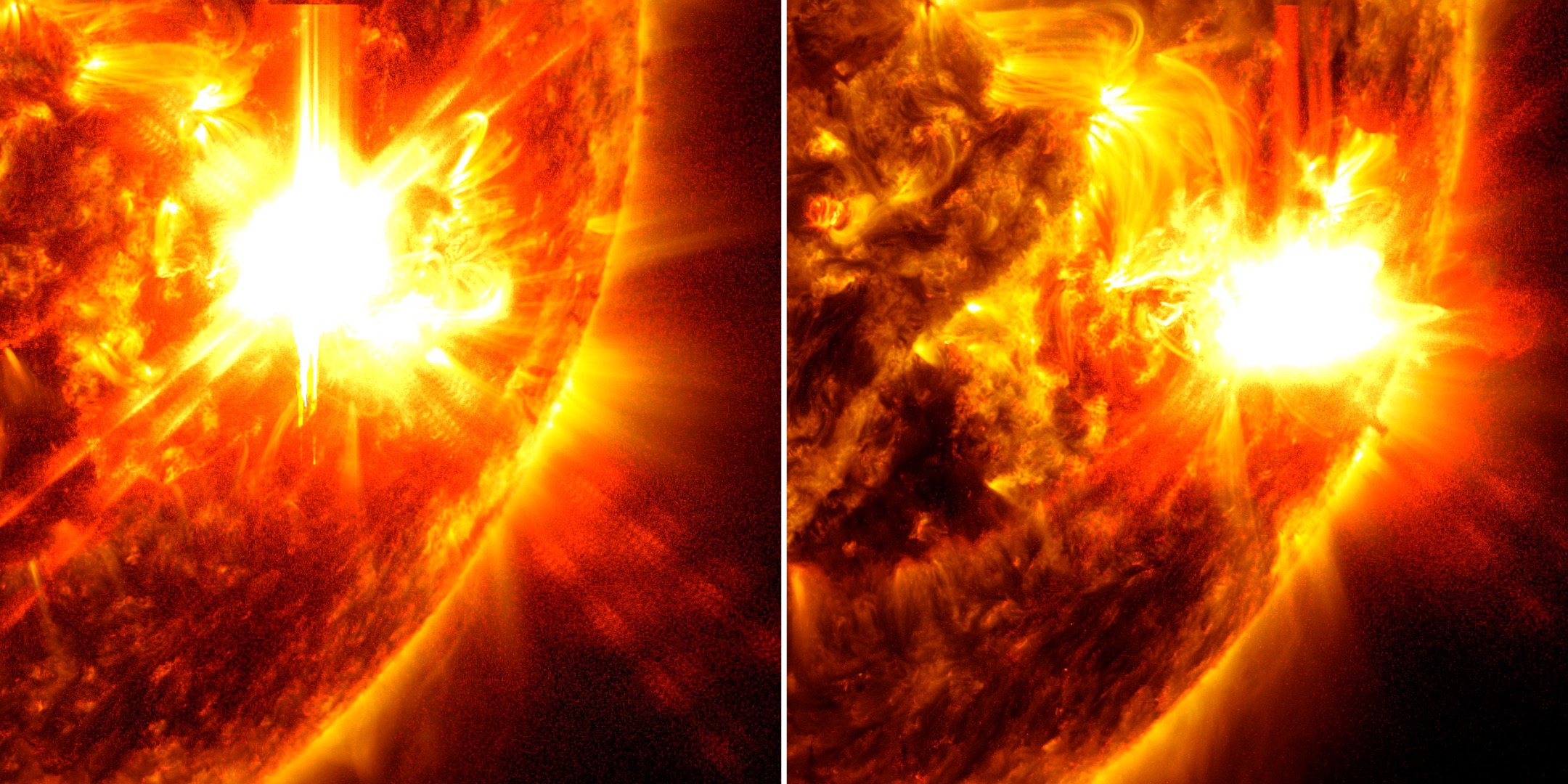May 2-10, 2024 : A Busy Week of Flares
Produced Video
Watch this video on the NASA Goddard YouTube channel.
Music Credit: “Halos” from the album Burning Clouds. Written and produced by Lars Leonhard. https://ultimae.bandcamp.com/track/halos
NASA’s Solar Dynamics Observatory captured this imagery of solar flares – as seen in the bright flashes on the upper center – on May 2, 2024. The image shows a blend of 171 Angstrom and 131 Angstrom light, subsets of extreme ultraviolet light.
Credit: NASA/SDO

NASA’s Solar Dynamics Observatory captured this image of an X1.6 solar flare – as seen in the bright flash in the upper center – on May 2, 2024. The image shows 131 Angstrom light, a subset of extreme ultraviolet light.
Credit: NASA/SDO

NASA’s Solar Dynamics Observatory captured this image of an X1.6 solar flare – as seen in the bright flash in the upper center – on May 2, 2024. The image shows a blend of 171 Angstrom and 131 Angstrom light, subsets of extreme ultraviolet light.
Credit: NASA/SDO
The Sun emitted three strong solar flares. The first flare peaked at 2:01 A.M. ET on May 5, 2024, and the second peaked at 7:54 A.M. ET on May 5, 2024. The third peaked at 2:35 A.M. ET on May 6, 2024. NASA’s Solar Dynamics Observatory, which watches the Sun constantly, captured an image of the event. The imagery shows 131 Angstrom light, a subset of extreme ultraviolet light. The sequence culminates wth an X4.5 flare.
Credit: NASA/SDO

NASA’s Solar Dynamics Observatory captured this image of an X4.5 solar flare – as seen in the bright flash in the upper right – on May 6, 2024. The image shows a blend of 171 Angstrom and 131 Angstrom light, subsets of extreme ultraviolet light.
Credit: NASA/SDO

NASA’s Solar Dynamics Observatory captured this image of an X4.5 solar flare – as seen in the bright flash in the upper right – on May 6, 2024. The image shows a blend of 171 Angstrom and 131 Angstrom light, subsets of extreme ultraviolet light.
Credit: NASA/SDO

NASA’s Solar Dynamics Observatory captured this image of an X4.5 solar flare – as seen in the bright flash in the upper right – on May 6, 2024. The image shows 131 Angstrom light, a subset of extreme ultraviolet light.
Credit: NASA/SDO

NASA’s Solar Dynamics Observatory captured this image of an X4.5 solar flare – as seen in the bright flash in the upper right – on May 6, 2024. The image shows 171 Angstrom light, a subset of extreme ultraviolet light.
Credit: NASA/SDO
NASA’s Solar Dynamics Observatory captured these images of the solar flares — as seen in the bright flashes in the left image (May 8 flare) and the right image (May 7 flare). The image shows 131 angstrom light, a subset of extreme ultraviolet light that highlights the extremely hot material in flares and which is colorized in orange. Credit: NASA/SDO
NASA’s Solar Dynamics Observatory captured this imagery of solar flares from May 7-8, 2024. The imagery shows 131 Angstrom light, a subset of extreme ultraviolet light.
Credit: NASA/SDO
NASA’s Solar Dynamics Observatory captured this imagery of solar flares from May 7-8, 2024. The imagery shows 131 Angstrom light, a subset of extreme ultraviolet light.
Credit: NASA/SDO

NASA’s Solar Dynamics Observatory captured this image of a strong solar flare on May 8, 2024. The image shows a blend of 171 and 131 Angstrom light, subsets of extreme ultraviolet light.
Credit: NASA/SDO

NASA’s Solar Dynamics Observatory captured this image of a strong solar flare on May 8, 2024. The image shows a blend of 171 and 131 Angstrom light, subsets of extreme ultraviolet light.
Credit: NASA/SDO

NASA’s Solar Dynamics Observatory captured this image of a strong solar flare on May 8, 2024. The image shows a blend of 171 and 131 Angstrom light, subsets of extreme ultraviolet light.
Credit: NASA/SDO

NASA’s Solar Dynamics Observatory captured this image of a strong solar flare on May 8, 2024. The image shows a blend of 171 and 131 Angstrom light, subsets of extreme ultraviolet light.
Credit: NASA/SDO

NASA’s Solar Dynamics Observatory captured this image of a strong solar flare – as seen in the bright flash in the upper right – on May 8, 2024. The image shows 131 Angstrom light, a subset of extreme ultraviolet light.
Credit: NASA/SDO

NASA’s Solar Dynamics Observatory captured this image of an X1.0 solar flare – as seen in the bright flash in the lower center – on May 8, 2024. The image shows 131 Angstrom light, a subset of extreme ultraviolet light.
Credit: NASA/SDO

NASA’s Solar Dynamics Observatory captured this image of an X2.2 solar flare – as seen in the bright flash in the lower center – on May 9, 2024. The image shows 131 Angstrom light, a subset of extreme ultraviolet light, colorized red.
Credit: NASA/SDO

NASA’s Solar Dynamics Observatory captured this image of an X3.9 flare on May 10, 2024. The image shows a blend of 171 and 131 Angstrom light, subsets of extreme ultraviolet light.
Credit: NASA/SDO

NASA’s Solar Dynamics Observatory captured this image of an X3.9 flare on May 10, 2024. The image shows a blend of 171 and 131 Angstrom light, subsets of extreme ultraviolet light.
Credit: NASA/SDO

NASA’s Solar Dynamics Observatory captured this image of an X3.9 flare on May 10, 2024. The image shows a blend of AIA 1600 Angstrom light and HMI Continuum.
Credit: NASA/SDO

NASA’s Solar Dynamics Observatory captured this image of an X3.9 flare on May 10, 2024. The image shows 131 Angstrom light, a subset of extreme ultraviolet light.
Credit: NASA/SDO
Credits
Please give credit for this item to:
NASA's Goddard Space Flight Center. However, individual items should be credited as indicated above.
-
Producers
- Scott Wiessinger (KBR Wyle Services, LLC)
- Beth Anthony (KBR Wyle Services, LLC)
-
Writers
- Abbey A. Interrante (ADNET Systems, Inc.)
- Joy Ng (KBR Wyle Services, LLC)
-
Data visualizer
- Tom Bridgman (Global Science and Technology, Inc.)
Release date
This page was originally published on Thursday, May 9, 2024.
This page was last updated on Saturday, May 11, 2024 at 9:45 AM EDT.


